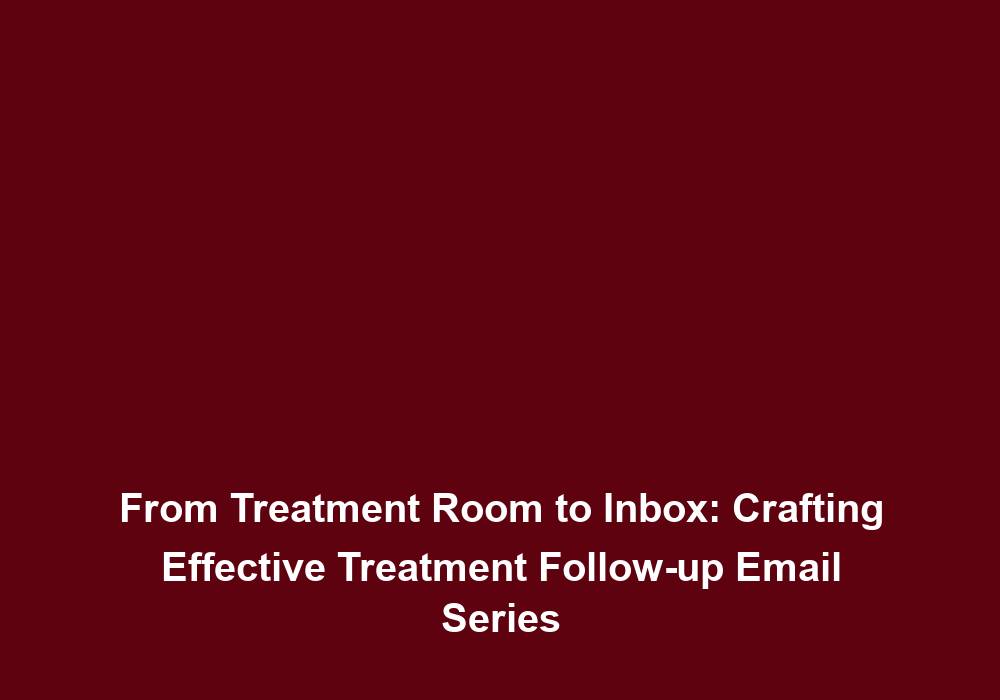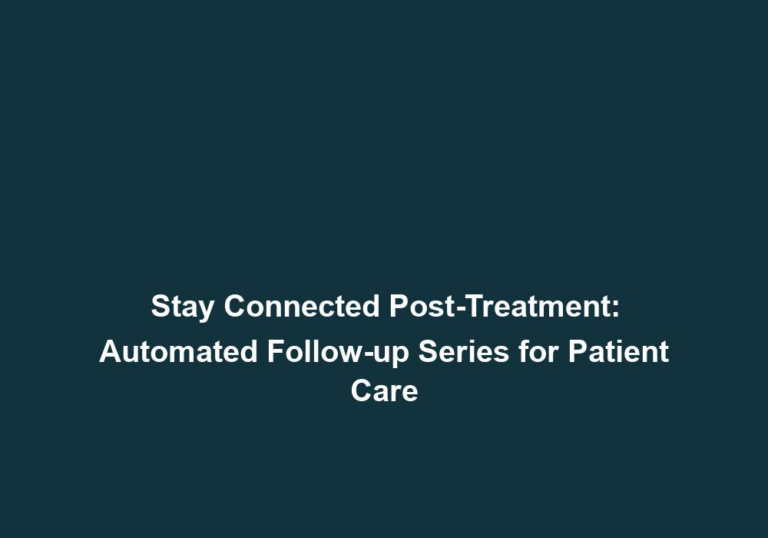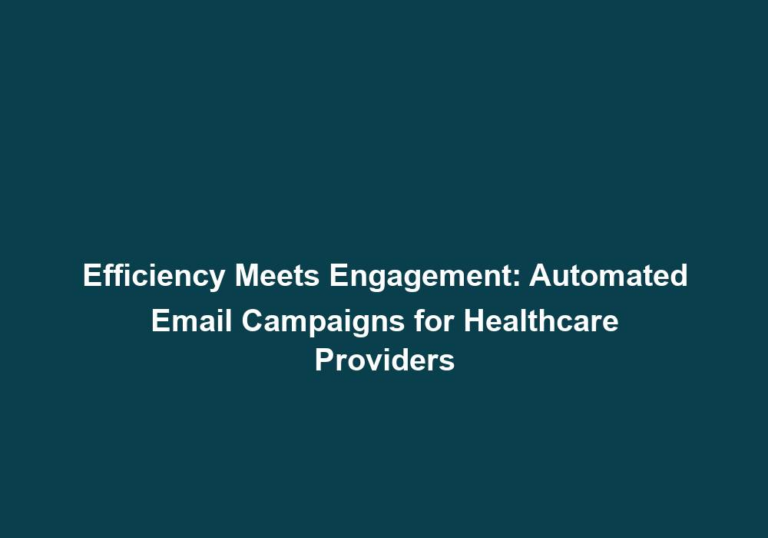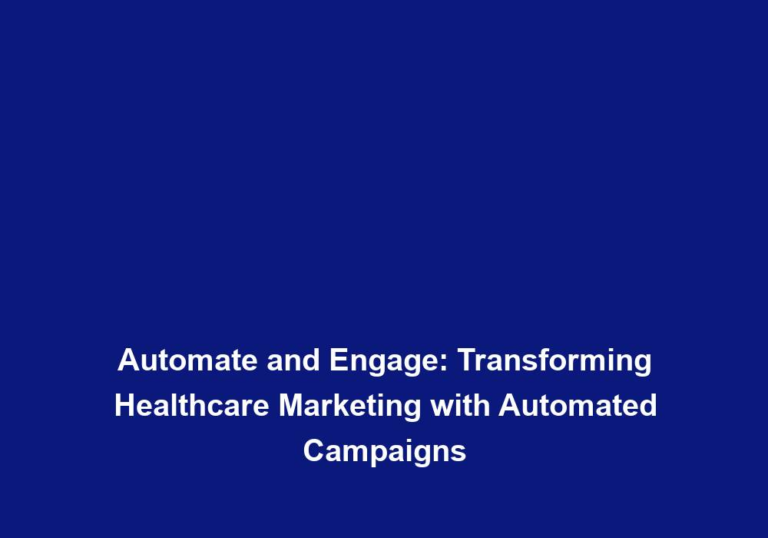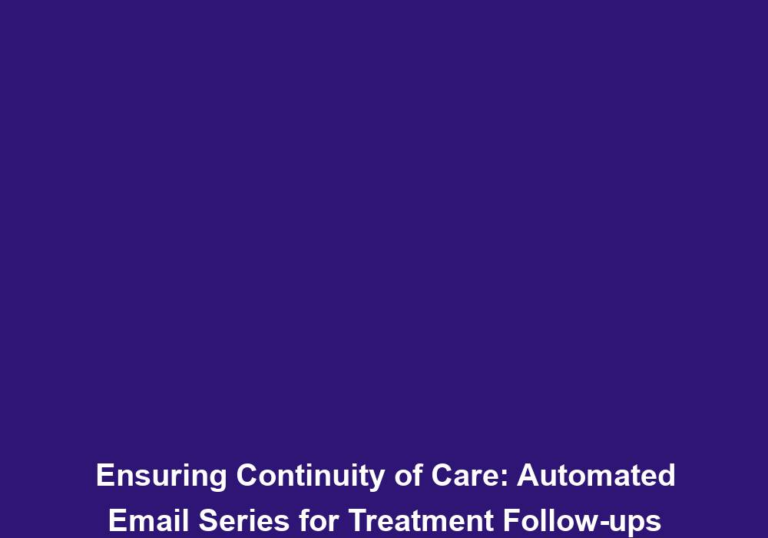From Treatment Room to Inbox: Crafting Effective Treatment Follow-up Email Series
In today’s digital age, communication plays a vital role in ensuring a successful treatment experience for patients. While face-to-face interactions are important, follow-up emails can further enhance the patient’s journey and maintain a strong connection. Crafting an effective treatment follow-up email series requires careful planning, thoughtful content, and a personalized approach. In this article, we will dive into the key elements and best practices for creating impactful treatment follow-up emails.
Importance of Treatment Follow-up Emails
- Keep patients engaged: Follow-up emails serve as a valuable touchpoint to keep patients engaged with their treatment progress. By consistently providing relevant information and support, you can foster a sense of trust and motivate patients to remain committed to their treatment plan.
Follow-up emails are an essential tool for keeping patients engaged throughout their treatment journey. They provide an opportunity to update patients on their progress, remind them of upcoming appointments, and offer encouragement and support. By consistently reaching out to patients, you can establish a strong connection and build trust, which ultimately leads to better treatment outcomes.
Some ways to keep patients engaged through follow-up emails include:
- Sharing personalized treatment updates: Tailor the content of your emails to each patient’s specific treatment plan and progress. Provide them with relevant information about their condition, the expected outcomes of their treatment, and any changes or adjustments that may be necessary.
- Offering ongoing support: Use follow-up emails to let patients know that you are available to answer any questions or address any concerns they may have. Encourage them to reach out if they need assistance or additional information.
- Providing educational resources: Include links to articles, videos, or other resources that can help patients further understand their condition and treatment options. Empowering patients with knowledge allows them to actively participate in their own healthcare and make informed decisions.
- Address concerns and questions: Treatment follow-up emails provide an opportunity to address any concerns or questions patients may have after their visit. By proactively addressing these issues, you can alleviate anxiety and ensure patients feel supported throughout their journey.
After a patient’s visit, it is common for questions or concerns to arise. By addressing these issues promptly through follow-up emails, you can help alleviate any anxiety or uncertainty the patient may be experiencing. This proactive approach shows patients that their well-being is a priority and that you are dedicated to providing comprehensive care.
Here are some effective strategies for addressing concerns and questions in follow-up emails:
- Be empathetic and understanding: Acknowledge the patient’s concerns and reassure them that their questions are important. Let them know that you are there to support them and provide any necessary information or guidance.
- Provide clear explanations: Use follow-up emails to provide detailed explanations or clarifications regarding any issues or questions raised by the patient. Break down complex information into easily understandable terms and provide examples or analogies if necessary.
- Offer additional resources: Include links to relevant articles, videos, or other resources that can help address the patient’s concerns or provide further information. This allows patients to explore the topic in more depth and gain a better understanding of their condition or treatment.
- Provide additional resources: Emails allow you to share additional resources such as articles, videos, or downloadable materials that can further educate patients about their condition and treatment options. This empowers patients to take an active role in their own healthcare and enhances their understanding of the treatment process.
In addition to addressing concerns and questions, follow-up emails offer an opportunity to provide patients with valuable resources that can enhance their knowledge and understanding of their condition and treatment options. By empowering patients with information, you enable them to make informed decisions and actively participate in their own healthcare.
Consider incorporating the following strategies when providing additional resources in follow-up emails:
- Tailor resources to patient’s needs: Take into account the specific needs and interests of each patient when selecting resources to share. Consider factors such as their treatment type, stage of treatment, or specific concerns. This personalized approach ensures that the resources are relevant and valuable to the individual patient.
- Offer a variety of formats: People have different learning preferences, so it’s important to offer resources in various formats. This could include articles, videos, infographics, or downloadable materials. By catering to different learning styles, you increase the chances of patients engaging with and benefiting from the resources.
- Highlight key takeaways: When sharing resources, provide a brief summary or highlight key takeaways to make it easier for patients to digest the information. This can help them quickly grasp the main points and understand the relevance of the resource to their own situation.
- Build long-term relationships: By regularly communicating with patients through follow-up emails, you can build long-term relationships and encourage them to become loyal advocates for your practice. Satisfied patients are more likely to refer others to your services and leave positive reviews, contributing to the growth of your practice.
Follow-up emails not only serve as a means of providing information and support but also as a way to foster long-term relationships with your patients. By consistently engaging with patients even after their treatment is complete, you can cultivate loyalty and turn them into advocates for your practice.
Here are some strategies for building long-term relationships through follow-up emails:
- Show appreciation: Express gratitude to patients for choosing your practice and entrusting you with their care. Let them know that their satisfaction and well-being are important to you.
- Seek feedback: Encourage patients to provide feedback on their treatment experience, whether positive or negative. This shows that you value their opinions and are committed to continuous improvement.
- Share success stories: Highlight success stories of other patients who have benefited from your services. This can instill confidence in current patients and further strengthen their belief in the quality of your care.
Crafting an Effective Treatment Follow-up Email Series
- Segmentation: To maximize the impact of your follow-up emails, consider segmenting your patient list based on factors such as treatment type, stage of treatment, or specific concerns. This allows you to tailor the content to each group’s specific needs, increasing the relevance and effectiveness of the emails.
Segmentation is a powerful strategy that allows you to create targeted follow-up emails that resonate with each patient group. By grouping patients based on relevant factors, such as their treatment type, stage of treatment, or specific concerns, you can deliver content that is highly relevant and valuable to them.
Consider the following segmentation approaches when crafting your follow-up email series:
- Treatment type: Patients undergoing different types of treatment may have varying information needs. By segmenting based on treatment type, you can provide specialized content that addresses the unique challenges and considerations associated with each treatment.
- Stage of treatment: Patients at different stages of treatment may require different types of information and support. Segmenting based on treatment stage allows you to deliver content that is timely and tailored to their specific needs at each stage.
- Specific concerns: Some patients may have specific concerns or conditions that require additional attention. By segmenting based on these concerns, you can provide targeted information and resources that directly address their unique situation.
- Personalization: Personalized emails are more likely to resonate with recipients. Address patients by their first name and use language that reflects their specific treatment journey. Additionally, referencing any specific concerns or goals discussed during their visit can demonstrate your attentiveness and commitment to their individual needs.
Personalization is key to creating impactful follow-up emails. By addressing patients by their first name and using language that reflects their specific treatment journey, you can make the emails feel more personalized and relevant to each individual. This helps to establish a stronger connection with the patient and increases the likelihood of engagement.
Here are some tips for personalizing your follow-up emails:
- Use the patient’s first name: Addressing patients by their first name adds a personal touch and makes the email feel more individualized.
- Refer to specific concerns or goals: If the patient discussed any concerns or goals during their visit, reference them in the follow-up email. This shows that you were attentive to their needs and that the email is tailored specifically for them.
- Customize the content: Tailor the content of the email to reflect the patient’s treatment journey and any specific information or resources that may be relevant to them. This customization makes the email feel more personalized and valuable to the patient.
- Clear and concise subject lines: The subject line of your email plays a crucial role in grabbing the recipient’s attention and enticing them to open it. Keep the subject line clear, concise, and relevant to the content of the email. Avoid using generic subject lines that may be perceived as spam.
The subject line is the first thing that recipients see when they receive your follow-up email. It is essential to craft subject lines that are clear, concise, and relevant to the content of the email. A compelling subject line increases the chances of the email being opened and read by the recipient.
Consider the following tips when creating subject lines for your follow-up emails:
- Be specific: Clearly state what the email is about in the subject line to give recipients a clear idea of what to expect when they open it.
- Keep it concise: Keep the subject line brief and to the point. Long subject lines may get cut off or appear overwhelming in the recipient’s inbox.
- Avoid spam triggers: Stay away from subject lines that may trigger spam filters. This includes using excessive capitalization, special characters, or misleading claims.
- Engaging content: The content of your follow-up emails should be informative, engaging, and easy to read. Use headings, bullet points, and numbered lists to break up the text and make it more scannable. Incorporate relevant visuals such as images or infographics to make the content visually appealing and enhance comprehension.
To create engaging follow-up emails, it is important to present the information in a format that is easy to read and understand. Utilize formatting techniques such as headings, bullet points, and numbered lists to break up the text and make it more scannable for the reader. Additionally, incorporating relevant visuals can enhance the overall appeal of the content and improve comprehension.
Consider the following techniques when crafting engaging content for your follow-up emails:
- Use headings: Break up the content into sections with clear headings. This helps readers navigate the email and locate the information they are most interested in.
- Utilize bullet points and numbered lists: Present information in a concise and organized manner using bullet points and numbered lists. This makes the content more digestible and allows readers to quickly grasp key points.
- Include visuals: Incorporate relevant images or infographics to support the content and make it visually appealing. Visual elements can help break up the text and enhance the overall readability of the email.
- Provide actionable information: Ensure that each follow-up email includes actionable information or next steps for the patient. This could include reminders for upcoming appointments, instructions for at-home care, or links to relevant resources. By providing clear guidance, you help patients stay on track and actively participate in their treatment journey.
Follow-up emails should provide patients with actionable information or next steps to help them navigate their treatment journey effectively. By including clear guidance and instructions, you enable patients to take proactive steps and stay engaged in their own healthcare.
Consider the following ways to provide actionable information in your follow-up emails:
- Include appointment reminders: Remind patients of upcoming appointments and provide any necessary instructions or preparations they need to make.
- Offer at-home care instructions: If applicable, provide detailed instructions for any at-home care patients need to perform. This could include medication schedules, wound care guidelines, or lifestyle recommendations.
- Share relevant resources: Include links to resources that can support patients in their treatment journey. This could be educational materials, exercise videos, or support group information. By providing these resources, you empower patients to take an active role in their own healthcare.
- Encourage feedback: Include a call-to-action that encourages patients to provide feedback or ask any additional questions they may have. This shows that you value their input and are committed to their satisfaction. Prompt responses to patient inquiries further improve patient satisfaction and strengthen the patient-provider relationship.
Follow-up emails provide an excellent opportunity to gather feedback from patients and address any additional questions or concerns they may have. By actively encouraging feedback, you demonstrate to patients that their opinions and experiences are valued, and you are committed to providing the best possible care.
Consider the following strategies to encourage feedback in your follow-up emails:
- Use a clear call-to-action: Include a specific request for feedback or questions in your email, such as “We would love to hear about your experience” or “Do you have any questions? Let us know!”
- Provide multiple contact options: Make it easy for patients to provide feedback by offering various contact methods, such as email, phone, or an online feedback form. This ensures that patients can choose the method that is most convenient for them.
- Respond promptly: When patients provide feedback or ask questions, respond promptly and thoughtfully. This demonstrates your commitment to their satisfaction and strengthens the patient-provider relationship.
- Maintain consistency: Consistency is key when it comes to the frequency of your follow-up emails. Find a balance that ensures patients stay engaged without overwhelming their inbox. Whether it’s weekly, bi-weekly, or monthly, establish a regular cadence that aligns with the patient’s treatment timeline and preferences.
Consistency is essential for maintaining engagement with your patients through follow-up emails. By establishing a regular cadence, you can keep patients informed and connected without overwhelming their inbox. Finding the right balance ensures that patients receive valuable updates and support at a frequency that aligns with their treatment timeline and preferences.
Consider the following tips for maintaining consistency in your follow-up email series:
- Establish a schedule: Determine the frequency at which you will send follow-up emails, whether it’s weekly, bi-weekly, or monthly. This schedule should align with the patient’s treatment timeline to ensure information is timely and relevant.
- Communicate the schedule: Let patients know what to expect by communicating the schedule of your follow-up emails upfront. This allows them to anticipate and look forward to receiving updates from you.
- Be reliable: Stick to the established schedule and consistently deliver follow-up emails as promised. This helps build trust with patients and ensures they continue to engage with your content.
- Monitor and analyze results: Regularly monitor the performance of your follow-up email series to identify areas for improvement. Track metrics such as open rates, click-through rates, and patient feedback. Use this data to refine your email content, subject lines, and overall strategy to optimize engagement and effectiveness.
To ensure the effectiveness of your follow-up email series, it is important to regularly monitor and analyze the results. By tracking important metrics and gathering patient feedback, you can identify areas for improvement and make data-driven decisions to optimize engagement and effectiveness.
Consider the following steps to monitor and analyze the performance of your follow-up email series:
- Track open rates and click

